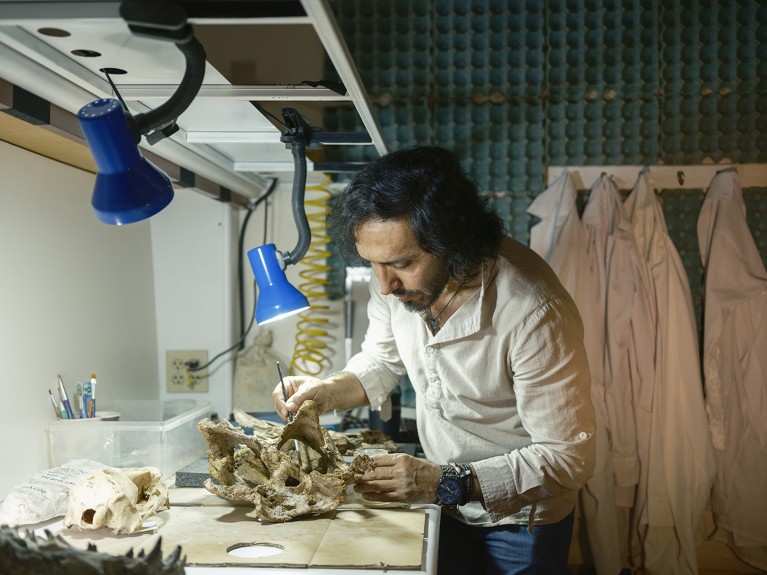Hello Nature readers, would you like to get this Briefing in your inbox free every day? Sign up here.

The primary visual cortex (yellow, artificially coloured) is involved in creating vivid visual memories, experiments show.Credit: Sovereign/ISM/SPL
Vivid memories that flash into the mind’s eye might be made in the primary visual cortex, the same area of the brain that processes raw visual input from the eyes. A study in monkeys suggests that neurons there display a different activity pattern when images are conjured up from memory compared with real-time vision. Some researchers say that other areas, such as the prefrontal cortex, are more likely to be the seat of the ‘mind’s eye’. “There’s a possibility that the actual memory encoding is happening elsewhere, and that what you’re seeing in the primary visual cortex is the downstream consequences,” says neuroscientist Floris de Lange.
Reference: Science Advances paper
Researchers are calling on the US Food and Drug Administration (FDA) to be more transparent in how it incorporates recommendations from independent scientists on its advisory panels when it approves drugs or makes other key decisions. These pleas came last week during a public listening session organized by the agency to ‘optimize’ its use of the panels — possibly by having these panels host fewer votes. In recent years, there have been some controversial examples of FDA overriding the consensus of its advisers — such when it approved the Alzheimer’s drug aducanumab. At the listening session, FDA commissioner Robert Califf said that “one of the most difficult areas that we need to address” is how to have a disagreement as a scientific community “without undermining the public’s confidence and trust in science”.
China wants to build the world’s largest particle smasher, the US$5-billion, 100-kilometre Circular Electron Positron Collider (CEPC). The collider could generate millions of Higgs bosons and analyze the properties of the mysterious particle in exquisite detail. If the project wins government approval, construction could begin in 2027 and would take around 10 years to complete. The facility would be cheaper and faster to build than a similar one, the Future Circular Collider (FCC), proposed in Europe. Given that China is already home to a collider that is similar to the CEPC — the Beijing Electron Positron Collider — the country might now have more expertise in this area than does all of Europe combined, says Frank Zimmermann, a physicist at CERN, Europe’s particle-physics laboratory, who chaired the review committee for the CEPC’s technical-design report and is also involved in the FCC.
Features & opinion
Financial management is an important, yet overlooked, skill for researchers. Here are some tips from budget-savvy researchers:
• Monitor spending using a spreadsheet
• Keep some spare money for emergencies or wish-list items
• Negotiate: bulk or group buying can get you discounts
• Involve your team in budget planning to foster responsible spending
• Ask colleagues for tips or example budgets
Scientists are finding new ways to measure how squeezing, stretching, pushing and pulling forces shape the development of every tissue in the body. Tiny oil-encapsulated droplets can sense stresses inside live embryos and optical tweezers can push and pull cell membranes or organelles. Some researchers are developing contact-free alternatives such as the ‘foambryo’ algorithm, which models embryos as foams of bubble-like cells. Researchers have to be aware that they’re studying living material. “There’s a little bit of trickiness there because you have to try to build tools about a substance that you don’t fully even understand,” says developmental biologist Alan Rodrigues.
Conservationists have launched an ambitious project to slow the spread by mosquitoes of avian malaria in Hawaii. They have so far released 10 million male Culex quinquefasciatus mosquitoes infected with a strain of Wolbachia, a naturally occurring bacterium that disrupts mozzie reproduction. The region’s birds, which have no natural immunity to avian malaria, can be killed with a single bite from an infected mosquito — and climate change is helping the invasive insects spread. The Wolbachia intervention is controversial, pricey and must be relentlessly repeated to have any hope of working. Meanwhile, wildlife centres are breeding the rarest birds in mosquito-netted enclosures in the hope that they can someday be released into the wild. “This is the last resort,” says bird conservationist Jennifer Pribble.
Where I work

Rodolfo Salas-Gismondi is a palaeontologist at Cayetano Heredia University and head of the vertebrate palaeontology department at the Museum of Natural History, both in Lima.Credit: Musuk Nolte for Nature
“In the past, scientists thought it was impossible to find fossils in the Amazon,” says palaeontologist Rodolfo Salas-Gismondi. The vegetation is dense, there are few exposed rock outcrops to dig into and rainstorms can wash away specimens overnight. That’s why he spends August and September searching the riverbanks, when the water level drops and fossils are exposed — and has participated in the discovery of 37 species. “We have found signs of a rich variety of crocodilian species — especially from the Miocene epoch (5 million to 23 million years ago),” he says. (Nature | 3 min read)
Last week, Leif Penguinson was marvelling at bulbous trees in the Xishuangbanna Tropical Botanical Garden of the Chinese Academy of Sciences. Did you find the penguin? When you’re ready, here’s the answer.
Thanks for reading,
Flora Graham, senior editor, Nature Briefing
With contributions by Katrina Krämer and Smriti Mallapaty
Want more? Sign up to our other free Nature Briefing newsletters:
• Nature Briefing: Microbiology — the most abundant living entities on our planet — microorganisms — and the role they play in health, the environment and food systems.
• Nature Briefing: Anthropocene — climate change, biodiversity, sustainability and geoengineering
• Nature Briefing: AI & Robotics — 100% written by humans, of course
• Nature Briefing: Cancer — a weekly newsletter written with cancer researchers in mind
• Nature Briefing: Translational Research — covers biotechnology, drug discovery and pharma

